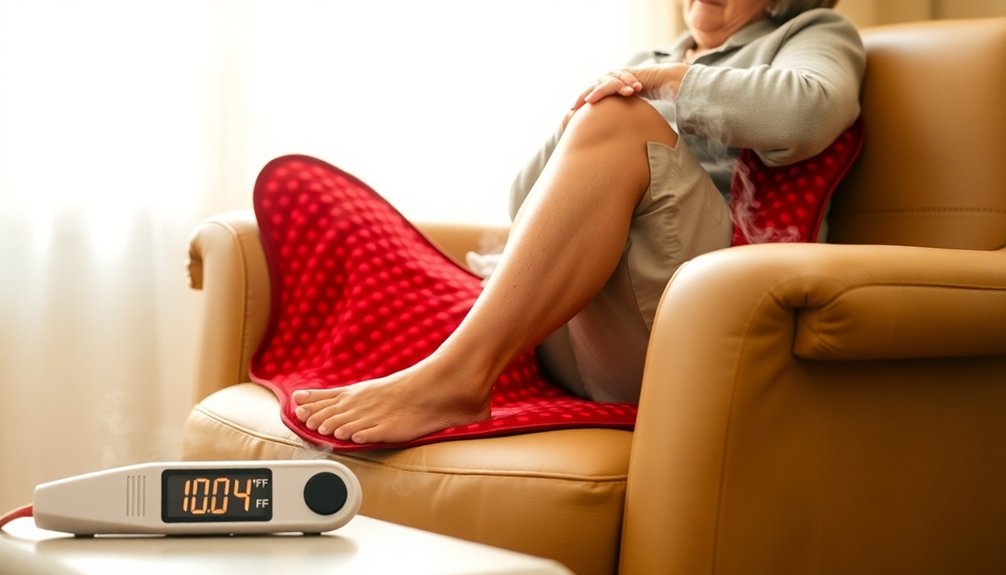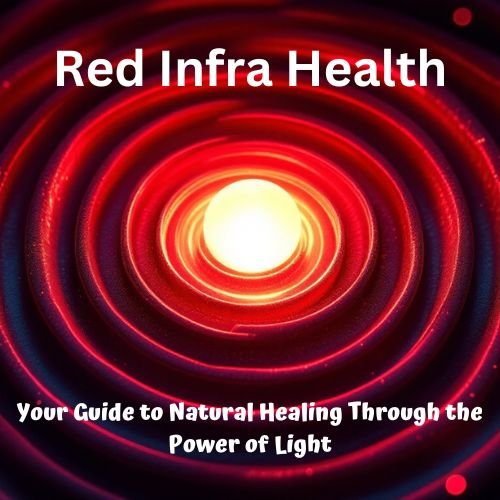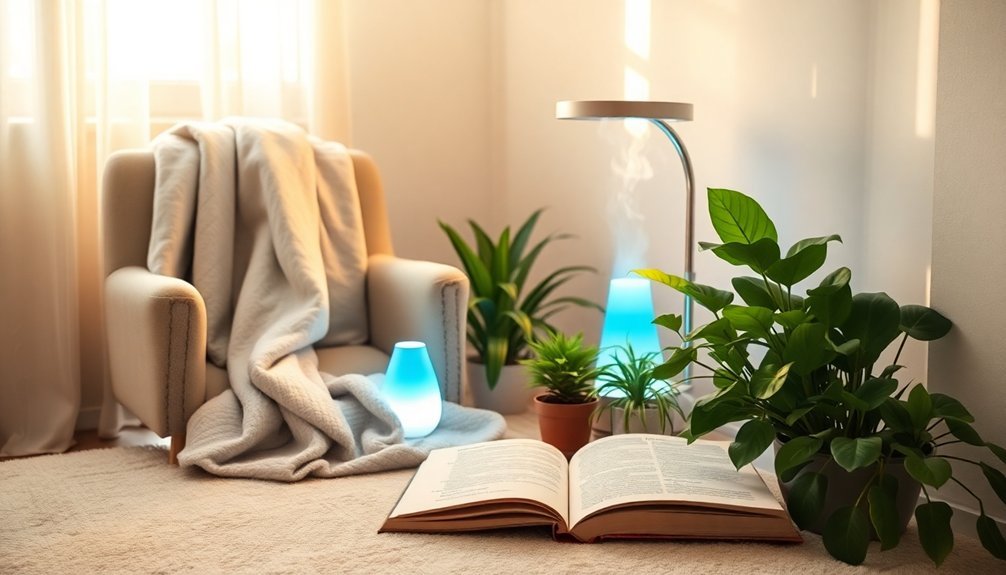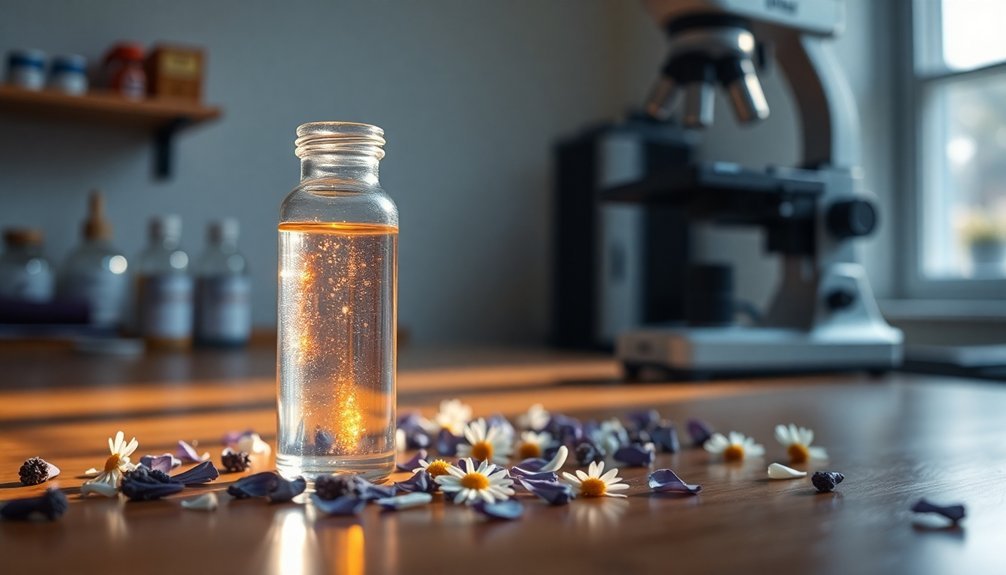Heat therapy can substantially improve your blood flow and circulation through several key mechanisms. When you apply controlled heat (95-109°F) to an area for 20-25 minutes, it causes your blood vessels to dilate, increasing blood flow and oxygen delivery throughout your body. You'll experience reduced muscle tension, better joint mobility, and decreased blood pressure as the heat enhances your vascular function and promotes the production of protective proteins. Using heating pads, warm baths, or infrared treatments can provide these circulation-boosting benefits, but you'll need to follow proper safety guidelines to maximize results. Discover how this natural therapy can transform your cardiovascular health.
Understanding Heat Therapy Basics

When you're seeking ways to improve circulation and ease muscle tension, heat therapy stands out as a time-tested solution. This therapeutic approach works primarily through vasodilation, which means your blood vessels expand, allowing blood to flow more freely through your body.
You'll benefit from increased oxygen and nutrient delivery to your tissues when you undergo heat therapy treatments.
For the best results, you'll want to maintain temperatures between 95 and 109 degrees Fahrenheit during your sessions. Each treatment should last 20-25 minutes to effectively raise your skin temperature.
You've got several options for applying heat therapy, including warm compresses, heating pads, heat wraps, warm soaks, and even paraffin wax treatments. Regular heat therapy can help reduce symptoms like tingling and numbness in your extremities.
Before you start any heat therapy regimen, it's crucial to follow proper safety protocols. Always place a thin towel or cloth barrier between the heat source and your skin to prevent burns and distribute heat evenly.
While heat therapy can effectively reduce muscle tension and improve flexibility, you should consult a healthcare professional first, especially if you have underlying health conditions.
Remember to monitor your skin's response and stick to recommended treatment times for the best outcome.
Benefits For Vascular Health
As research continues to demonstrate, heat therapy offers significant cardiovascular benefits by reducing blood pressure and enhancing overall vascular function. When you undergo heat therapy, your blood vessels relax and dilate, leading to improved blood flow throughout your body. Older adults aged 65+ face increased cardiovascular risks from heat exposure.
Studies show specific reductions in blood pressure measurements, with mean arterial pressure dropping by 5.86 mmHg, systolic by 3.94 mmHg, and diastolic by 3.88 mmHg.
- Enhances flow-mediated dilation, improving your body's natural ability to regulate blood flow
- Increases production of heat shock proteins that protect your cardiovascular system
- Stabilizes nitric oxide synthase, contributing to better vascular health
- Promotes vascular remodeling through enhanced shear patterns
The benefits extend beyond just blood pressure reduction. You'll experience improved microvascular function and potentially reduced arterial stiffness. Heat therapy works by increasing your cardiac output and redistributing blood flow to your periphery.
While it's proven effective for both healthy individuals and those with clinical conditions, you'll need controlled application to avoid cardiovascular strain. If you have heart conditions, you should work with healthcare providers to develop a tailored heat therapy approach that's safe and effective for your specific needs.
Common Circulation Problems

You'll want to watch for warning signs of poor circulation like numbness, cold extremities, and persistent fatigue, which can indicate serious underlying health issues.
These symptoms often stem from conditions such as atherosclerosis, diabetes, or blood clots that obstruct normal blood flow throughout your body. Physical inactivity and sedentary behaviors can contribute significantly to circulation problems by promoting fat buildup in your arteries.
While lifestyle changes and medical treatments can help manage circulation problems, you might need to explore options like heat therapy, medication, or specialized exercises depending on your specific condition.
Poor Circulation Warning Signs
Recognizing the warning signs of poor circulation can help you identify and address potential health issues before they become severe. Your body often sends clear signals when blood flow isn't at its best, and catching these symptoms early can prevent serious complications like blood clots or organ damage.
Watch for these critical warning signs:
- Persistent numbness and tingling in your hands and feet
- Unexplained pain or cramping in your legs and feet
- Slow-healing wounds or frequent infections
- Changes in skin color, especially bluish or pale tones
If you're experiencing cold extremities along with swelling in your arms or legs, it's time to pay attention. You might notice your skin becoming unusually dry or itchy, particularly in your legs.
These symptoms often accompany visible signs like varicose veins, which indicate circulation problems in your lower extremities. Leg heaviness and aching commonly occur when sitting or standing for extended periods. Don't ignore burning sensations in your feet or toes, as this could signal reduced blood flow to these areas.
When these symptoms persist, especially if they're accompanied by muscle cramps during physical activity, consult a healthcare provider for proper evaluation and treatment recommendations.
Blood Flow Obstruction Causes
Blood flow obstructions can develop from numerous medical conditions and lifestyle factors that affect your circulatory system. The most common causes include blood clots, which can form due to inherited disorders, cancer, or inflammatory diseases. You're at higher risk of developing clots if you're pregnant or taking oral contraceptives.
Physical blockages can occur when tumors press against blood vessels or when fatty deposits build up in your arteries (atherosclerosis).
Some people are born with unusually narrow blood vessels, while others develop narrowing due to scarring from infections or autoimmune conditions.
Systemic conditions like diabetes can damage your blood vessels over time, making them more susceptible to blockages. If you have an autoimmune disease, it may cause inflammation of your arteries, leading to restricted blood flow. Additionally, certain infections can trigger scarring that narrows your blood vessels.
You might also experience blood flow obstruction from vessel spasms, particularly in conditions like Raynaud's disease, where your blood vessels constrict excessively in response to stress or cold temperatures.
Peripheral vascular disease, often caused by atherosclerosis or infections like syphilis, can also markedly reduce blood flow to your extremities.
Circulation Treatment Options
Several effective treatment options exist for addressing common circulation problems, ranging from simple lifestyle modifications to advanced medical interventions. You'll find both natural remedies and medical treatments that can help improve your blood flow and overall cardiovascular health.
- Regular exercise and weight management are vital lifestyle changes that directly improve circulation
- Heat therapy combined with compression socks can provide immediate relief for poor circulation
- Medical procedures like angioplasty and stents offer solutions for serious blockages
- Natural supplements and a heart-healthy diet support long-term circulatory health
If you're dealing with circulation issues, you can start with lifestyle modifications like quitting smoking, maintaining a healthy diet, and exercising regularly.
For more severe cases, your doctor might recommend medications to treat underlying conditions like high blood pressure or diabetes.
Medical interventions such as bypass surgery or angioplasty become necessary when there are significant blockages in your arteries.
You can also complement these treatments with therapeutic approaches like compression therapy and heat treatment.
The key is working with your healthcare provider to determine the most appropriate combination of treatments based on your specific condition and its severity.
Heat Application Methods
You'll find several effective tools for heat therapy, including heating pads, warm compresses, and paraffin wax baths, each designed to safely improve your circulation.
To maximize benefits, you should apply heat for 15-20 minutes at a time using a protective barrier like a towel to prevent burns and guarantee even distribution.
Whether you choose dry heat methods like heating pads or moist heat options such as steam baths, you'll need to monitor your skin's response and adjust the temperature accordingly.
Safe Heat Therapy Tools
Numerous safe and effective tools are available for applying therapeutic heat to your body. These tools range from simple heating pads to advanced thermal therapy devices, each designed to improve circulation and promote healing in specific areas of your body.
When selecting a heat therapy tool, you'll want to evaluate the target area and the type of heat delivery that works best for your needs.
- Moist heat pads and wraps penetrate deeply into tissues and are excellent for relieving muscle tension.
- Electric heating pads offer convenient, portable relief with adjustable temperature settings.
- Far infrared heating devices provide deep tissue penetration without intense surface heat.
- Thermal therapy devices combine heat with additional benefits like vibration or compression.
For targeted relief, you'll find specialized tools designed for specific body parts. Neck and shoulder wraps conform to your upper body, while knee and elbow wraps provide focused joint support.
If you're treating your hands, mitten-style heat therapy products can help with arthritis and tendonitis.
Remember to always use protective covers and follow time limitations to prevent burns. It's also important to maintain proper temperature control and consult healthcare professionals for guidance on the most appropriate heat therapy tools for your condition.
Best Application Techniques
The effectiveness of heat therapy largely depends on proper application methods and timing. You'll find two primary methods to apply heat: dry heat therapy using heating pads or hot water bottles, and moist heat therapy through steamed towels or warm baths between 92-100°F.
When applying heat, you'll want to maintain direct contact with the affected area for no more than 20 minutes at a time. Wait at least two hours between sessions to prevent skin irritation.
For deeper tissue treatment, you might benefit from professional infrared radiation or ultrasound therapy, which can penetrate beneath the surface without direct skin contact.
You'll achieve the best results by keeping the temperature comfortably warm rather than hot. Watch your skin for any signs of irritation or discomfort during treatment.
If you're dealing with muscle stiffness or chronic pain, you can enhance the therapy's effectiveness by combining it with gentle stretching or rehabilitation exercises.
Remember to avoid heat therapy if you have acute inflammation, fever, or circulatory problems. If you're pregnant or have specific health conditions, consult your healthcare provider before starting any heat therapy routine.
Safety During Treatment Sessions

Maintaining proper safety protocols during heat therapy stands out as a critical aspect of treatment success. You'll need to monitor your skin regularly for signs of injury, such as severe redness, swelling, or pain.
Keep the temperature below 140°F and limit sessions to 15-20 minutes to prevent thermal burns. If you have conditions like diabetes, deep vein thrombosis, or heart failure, consult your healthcare provider before starting heat therapy.
- Never place heating devices underneath your body – always position them on top
- Remove the heat source immediately if you experience discomfort or unusual skin changes
- Use protective covers and devices with accurate temperature controls
- Check your skin every few minutes, especially if you have decreased sensation
When applying heat therapy, you'll want to be extra cautious if you're elderly, have chronic medical conditions, or experience reduced skin sensitivity. Watch for signs of adverse effects like increased swelling or sudden drops in blood pressure.
If you're using moist heat, you might need less time to achieve the desired results compared to dry heat. Remember, if you have open wounds or peripheral vascular disease, heat therapy isn't recommended as it can worsen your condition.
Blood Flow Enhancement Techniques
Building on proper safety protocols, effective blood flow enhancement combines various therapeutic approaches that work together to optimize circulation. You'll want to incorporate both active and passive techniques to maximize your results. Regular aerobic exercise, strength training, and yoga can substantially boost your circulation while relaxation practices help prevent vessel constriction from stress.
| Activity Type | Benefits |
|---|---|
| Aerobic Exercise | Oxygenates blood cells, improves cardiovascular health |
| Strength Training | Enhances blood flow to working muscles |
| Heat Therapy | Expands blood vessels, increases local circulation |
| Compression | Assists upward blood flow, reduces pooling |
| Movement Breaks | Prevents stagnation, activates leg muscle pumps |
To enhance these effects, you'll benefit from combining therapeutic interventions like heat therapy with lifestyle modifications. Using a standing desk, staying hydrated, and maintaining a healthy weight all contribute to better circulation. Consider incorporating interval training, which alternates between high-intensity activity and rest periods to boost cardiovascular efficiency. Don't forget about alternative therapies like massage or hydrotherapy – they can effectively complement your primary circulation-boosting activities while helping to flush out metabolic waste products.
Healing Through Infrared Light

Infrared light therapy revolutionizes modern healing approaches by harnessing specific wavelengths that penetrate deep into body tissues. When you expose your body to infrared light, it triggers a cascade of healing responses, from improved blood circulation to enhanced cellular function.
Your blood vessels dilate, allowing for better blood flow throughout your body, while the mitochondria in your cells produce more ATP, boosting your natural healing processes.
- Reduces chronic pain and inflammation, with 77% of patients able to return to work after treatment
- Improves cardiovascular health by enhancing blood vessel functionality and reducing blood pressure
- Accelerates healing after surgery, particularly for orthopedic procedures and rotator cuff repairs
- Activates cellular repair through photobiomodulation and increased nitric oxide production
You'll find this therapy particularly effective for treating various conditions, from fibromyalgia to arthritis. The treatment works by stimulating your body's natural healing mechanisms through increased blood flow and cellular regeneration.
Whether you're dealing with joint stiffness, muscle pain, or cardiovascular issues, infrared light therapy offers a non-invasive solution that targets the root cause of these problems at the cellular level.
Research Behind Heat Therapy
The science behind heat therapy reveals compelling evidence for its effectiveness in improving cardiovascular health and circulation. Research shows that regular heat therapy sessions can substantially reduce blood pressure while enhancing vascular function through increased flow-mediated dilatation.
Studies demonstrate that heat therapy sessions lasting 30-90 minutes can produce measurable improvements in cardiovascular health markers. You'll find both dry and moist heat applications effective, though moist heat often penetrates tissues more effectively.
| Benefit | Research Finding |
|---|---|
| Blood Pressure | Decreases mean arterial, systolic, and diastolic pressure |
| Circulation | Improves blood flow through vasodilation and enhanced vascular function |
| Tissue Health | Increases oxygen uptake and metabolic rate in treated areas |
Clinical evidence supports heat therapy's role in managing various conditions, from chronic muscle pain to cardiovascular disease risk factors. The research particularly highlights how continuous low-level heat applications can produce sustained improvements in blood flow and circulation. Scientists have documented that heat therapy works by naturally triggering your body's vasodilation response, which widens blood vessels and increases circulation to treated areas.
Daily Circulation Boosting Practices

Improving your circulation doesn't have to be complicated – you can work several simple practices into your daily routine. By combining movement, exercise, proper nutrition, and relaxation techniques, you'll help your blood flow more effectively throughout your body.
Start by taking regular breaks to stretch and walk during long periods of sitting, and consider alternating between sitting and standing at your desk.
- Take the stairs instead of the elevator to get your blood pumping
- Practice ankle movements and stretches while working at your desk
- Stay hydrated and eat circulation-boosting foods like garlic and leafy greens
- Use compression socks during long periods of sitting
Make exercise a priority by incorporating activities that specifically target circulation. Whether you choose yoga, cycling, or strength training, aim for daily movement that gets your heart rate up.
You can also enhance these efforts through heat therapy, like taking warm baths or using heating pads on tense muscles.
Don't forget the power of massage and relaxation techniques – they're excellent tools for improving blood flow while reducing stress.
Remember to maintain a balanced diet rich in fruits, vegetables, and lean proteins while avoiding circulation-restricting substances like alcohol and tobacco.
Frequently Asked Questions
Can Heat Therapy Help With Nerve Pain and Neuropathy?
Yes, heat therapy can help ease your nerve pain and neuropathy by increasing blood flow, promoting healing, reducing inflammation, and improving nerve conduction. You'll find relief through methods like infrared therapy and warm compresses.
How Long Should I Wait Between Heat Therapy Sessions?
You should wait at least one hour between heat therapy sessions. You can repeat treatments up to three times daily, but always listen to your body and adjust timing based on your comfort level.
Does Heat Therapy Interact With Blood-Thinning Medications?
Yes, heat therapy can interact with blood-thinning medications by increasing blood flow, which may raise your bleeding risk. You'll need to consult your healthcare provider before starting heat therapy if you're taking blood thinners.
Can Pregnant Women Safely Use Heat Therapy for Circulation?
You can safely use heat therapy while pregnant with proper precautions. Keep sessions brief (10-15 minutes), use warm (not hot) temperatures, avoid direct abdominal contact, and always consult your healthcare provider first.
Will Heat Therapy Affect My Blood Sugar Levels if I'm Diabetic?
Yes, heat therapy can affect your blood sugar levels. You'll need to monitor carefully as heat may lower levels by increasing insulin absorption, or raise them through dehydration. Consult your doctor before starting.
In Summary
You'll find heat therapy to be a powerful tool for improving your circulation and overall vascular health. Whether you're using infrared treatments, warm compresses, or therapeutic baths, consistent application can help reduce pain, speed healing, and boost blood flow. Remember to start slowly, follow safety guidelines, and combine heat therapy with other healthy practices like movement and hydration for the best results.





Leave a Reply